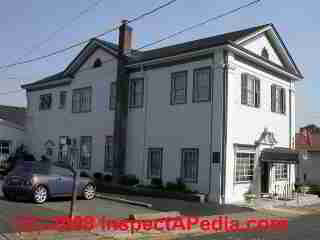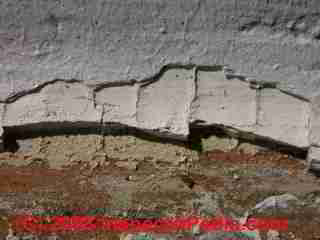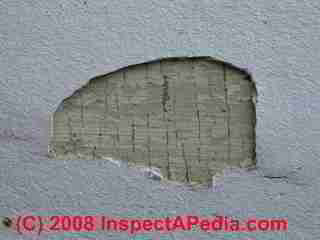 Case Study & Photographs of Paint Failure on a Wood-Sided Building
Case Study & Photographs of Paint Failure on a Wood-Sided Building
- POST a QUESTION or COMMENT about diagnosing the cause of paint troubles
Photographs of paint failures on buildings:
What do different types of paint failiure look like on buildings? These onsite paint failure photographs help explain the cause of paint peeling, cracking, chalking, and other paint problems on buildings. How to sort through arguments and blame when the paint job on a building fails miserably: peeling, cracking, falling off of painted wood surfaces.
Demonstration of a paint-adhesion test: procedures, photographs. This is a paint failure inspection, diagnosis, and remedy case study: this article series presents field and lab annotated photographs of severe paint failure on a wood sided pre-1900 building in New York.
InspectAPedia tolerates no conflicts of interest. We have no relationship with advertisers, products, or services discussed at this website.
- Daniel Friedman, Publisher/Editor/Author - See WHO ARE WE?
Paint Failure Site Photos (selected) - numbers refer to citations in lab sample table
After a painter skim-coated old paint on the wood siding using 40 gallons of Sherwin Williams C-70 crack and hole filler (not a recommended use of this product), a rapid and extensive failure of the new painted surfaces was evident in less than 90 days.
[Click to enlarge any image]
Extensive stripping and surface preparation will be required to restore the building. The skim-coat product, a substance intended for small crack and hole filling, was used in violation of the manufacturer's instructions.
The accompanying photographs taken in our forensic lab provide examples of paint contaminants or other conditions associated with paint failures that can be of assistance to analysts investigating paints on buildings, artifacts, and works of art.
Pre-1900 wood sided building in New York's Hudson Valley, site photo providing context for the close-up photographs of exterior paint problems shown below.
Site 025 loose, alligatored paint low on walls, an insecure surface that needed to be stripped prior to painting.
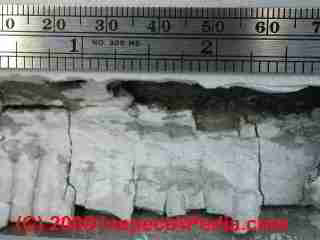
Site 031 surface of wood clapboard below loose falling-off alligatored paint - this condition was not visible in most areas due to the skim-coating.

Site 032 Demonstrating that skim coat was applied over loose failing and alligatored paint on the building exterior wall
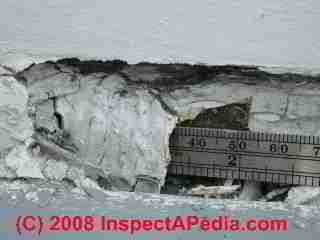
Site 034 wall surface below failed paint. The light colored wood in lower photo has been exposed to weather following paint failure.

Site 035 shows improper use of skim coat material at clapboard butt joint -specifically advised-against by the coating manufacturer.
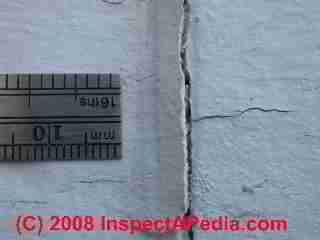
Site 036 shows loose falling off skim coat and paint at clapboard butt joint
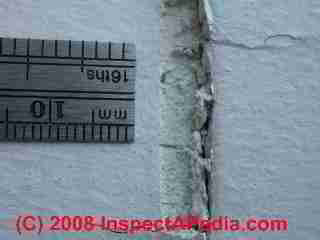
Site 039 preparing an adhesion test in the painted surface near a failed butt joint
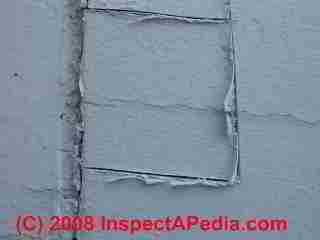
Site 043 paint adhesion test in process
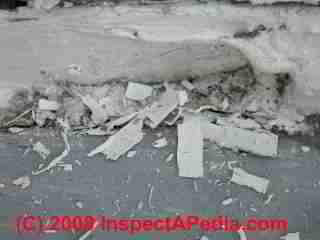
Site 044 paint adhesion test in process
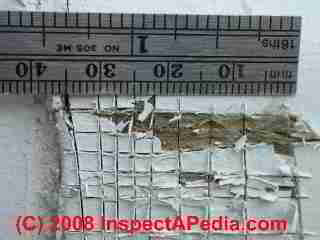
Site 048 paint adhesion test showing removal of new paint from old surface, varying by closeness of the razor cuts
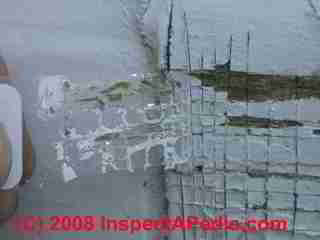
Site 050 example of vertical crack in skim coated material; also note the pattern of paint finish indicating that a paint roller was used to apply paint.
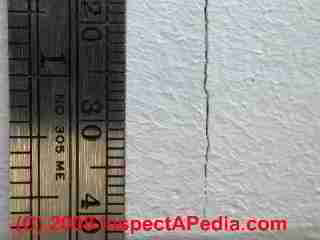
Site 052 preparing an investigative razor cut to the right of a pre-existing vertical crack in skim coated painted building

Site 054 exploring vertical crack in skim coated painted building
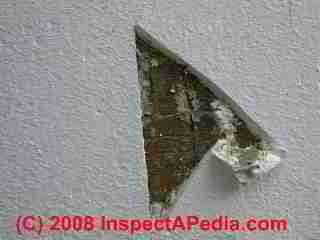
Site 059 depth of skim coat plus old and new paint exceeds 2mm

Site 064 evidence of painting over dirt on siding low on building walls
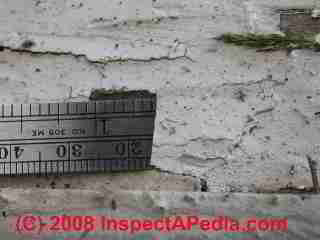
Site 067 failure of edge of skim coat over old paint

Site 069 measuring depth of failed skim coat and paint on building wall
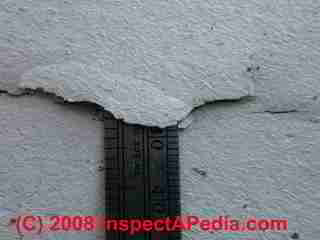
Site 070 skim coat and new paint falling off reveal adhered older paint layers, confirming that paint failure was not due to moisture push from building interior conditions

Site 071 back surface of failed paint chip can be examined for evidence of failure cause
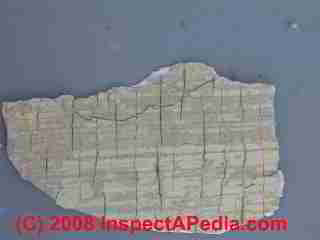
Site 078 example of failure in skim coat painted surface
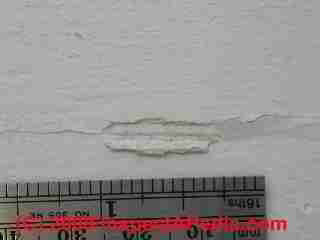
Site 079 example of failure of skim coated over clapboard butt joint
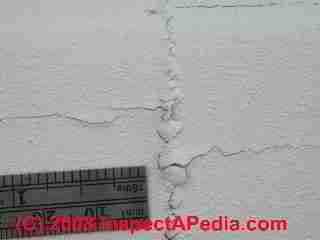
Site 081 example of horizontal cracking in coating applied over clapboards before painting
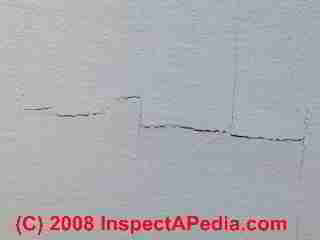
Site 083 probing multiple cracks in painted surface
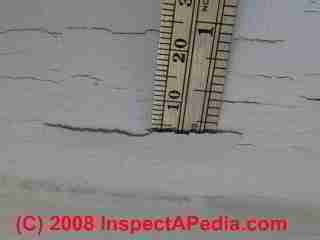
Site 084 new paint adhesion failure over skim coat
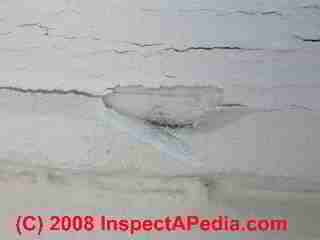
Site 091 example of thick skim coat over loose old paint
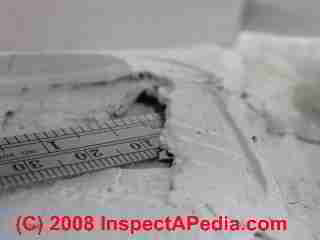
Site 092 example of thick skim coat over loose old paint - detail

Site 095 measuring long horizontal crack failure in painted building exterior
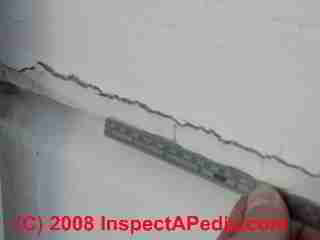
Site 096 probing horizontal crack in painted skim coat on building exterior - to 10mm of loose paint
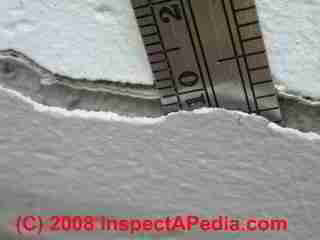
Site 097 crumbling skim coated crack filler on building exterior leads to paint failure; note dirt and debris, possibly mold growth between layers of material
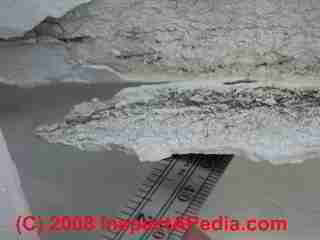
Site 100 probing horizontal and vertical paint crack failure

Site 101 paint failure example on building exterior wall
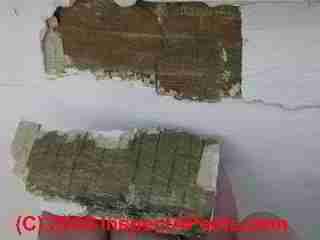
Site 106 paint failure example - paint falling off of building over skim coat

Site 109 one of the paint products used - the skim coat of crack filler (Sherwin Williams C-70 not applied according to manufacturer's instructions) was the root cause of paint failure on this building, not the choice of primer nor top coat of paint.
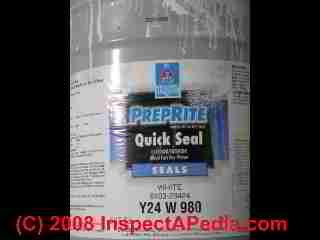
Site 123 skim coat and paint failing over building trim

Site 124 skim coat and paint failing over building trim

Site 128 skim coat and paint failing over building trim
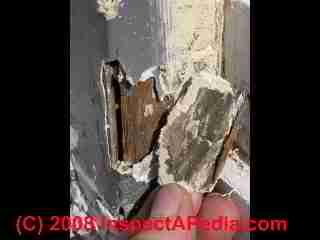
Site 130 probing thick skim coat failure - note older paint remaining adhered to surface - area was "touched up" after peeling paint began
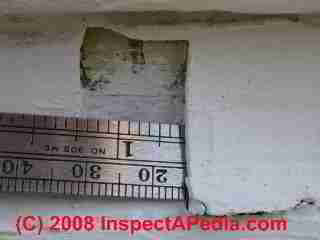
Site 146 sidelight shows skim coating over irregular alligatored and cracked loose paint on clapboards - failing within 90 days of application
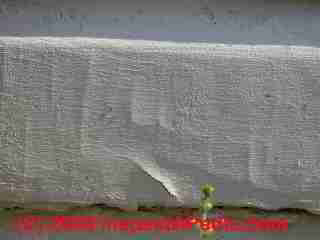
Site 147 sidelight shows skim coating over irregular alligatored and cracked loose paint on clapboards - failing within 90 days of application

Site 149 crumbling skim coating painted-over is failing and releasing paint from surface
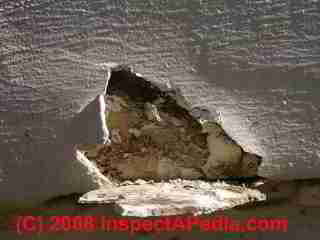
Site 150 crumbling skim coating painted-over is failing and releasing paint from surface
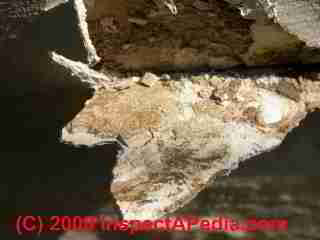
Site 154 typical example of multiple shrinkage cracks in skim coat applied to building exterior as a shortcut where surface preparation was omitted
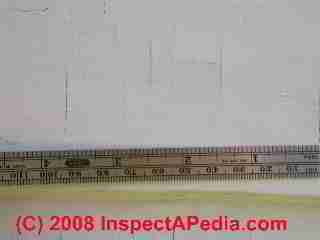
Site 156 skim coat and paint failure below clapboard edge
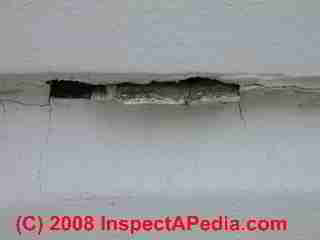
Site 157 paint failure showing older adhered paint layer below confirms that interior building moisture was not a prime cause of lost paint on this surface

Site 161 test cut to bare wood
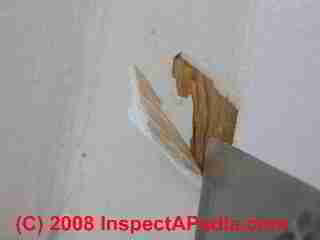
Site 172 probing failing paint on building exterior walls
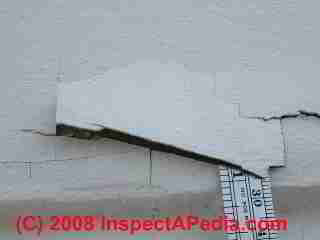
Site 177 probing failing paint on building exterior walls
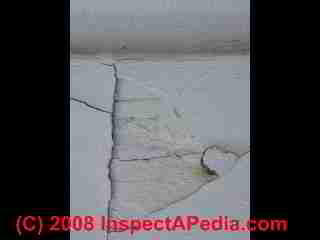
Site 182 probing failing paint on building exterior walls - note mold growth on back of paint chip
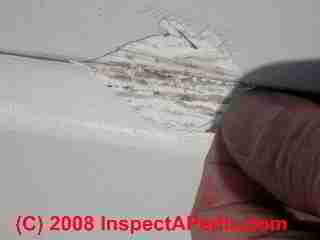
Site 185 documenting thickness of skim layer
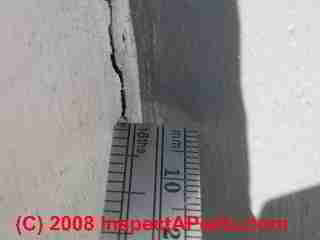
Site 189 documenting depth of skim layer on trim
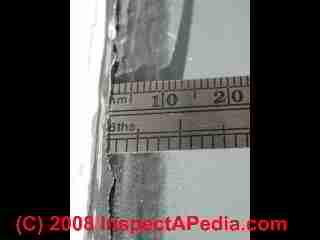
Site 192 documenting condition of failing paint coating on building exterior trim
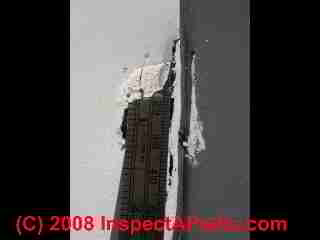
Site 195 documenting condition of failing paint coating on building exterior trim
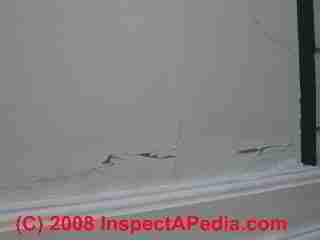
Site 201 documenting condition of failing paint coating on building exterior trim
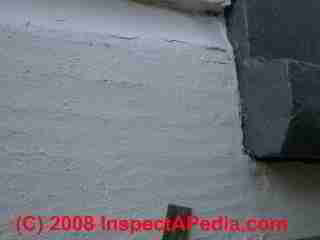
Site 203 documenting condition of failing paint coating on building exterior trim
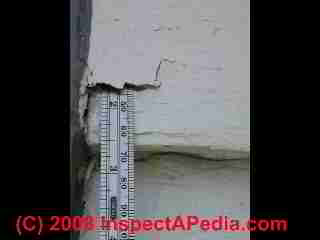
Site 205 documenting condition of failing paint coating on building exterior trim
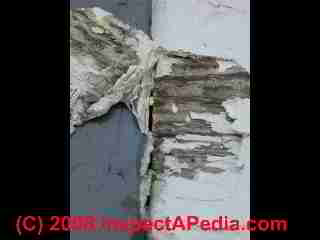
Site 208 typical horizontal crack failures in exterior paint coating on wood clapboards - paint applied over C-70 skim coat
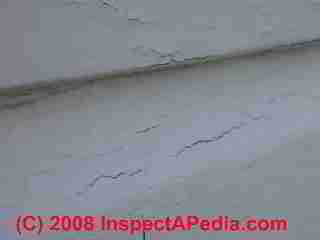
Site 211 typical paint failures in exterior paint coating on wood clapboards - paint applied over C-70 skim coat
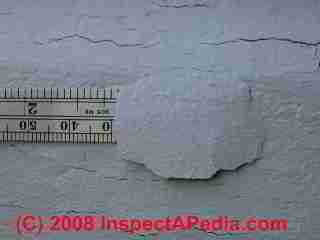
Site 212 mold on back of paint chip can indicate inadequate surface cleaning prior to painting but in this case it is primarily due to moisture penetration of the paint layers
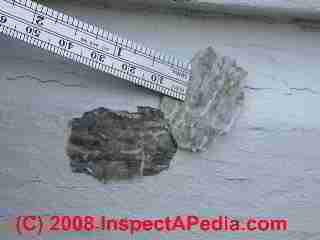
Site 219 cracking exterior paint over skim coat
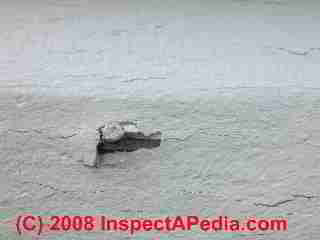
Site 220 cracking exterior paint on wood wall

Site 222 probing loose exterior paint

Site 242 probing loose exterior paint
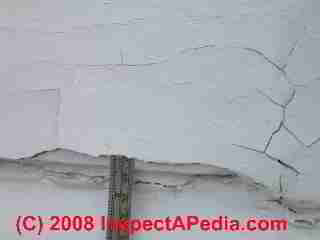
Site 243 probing loose exterior paint
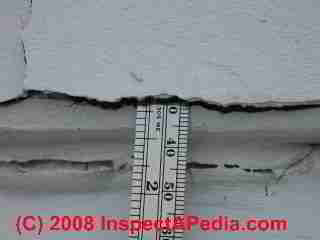
Site 245 probing loose exterior paint
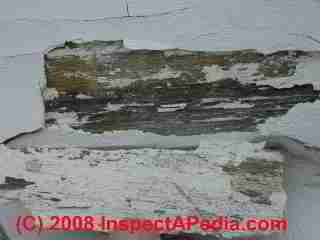
Site 246 probing loose exterior paint

Site 281 test boards preserved from building exterior demonstrate improper surface preparation and skim coat basis of extensive paint failure
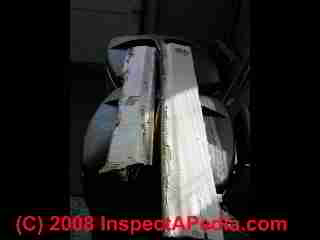
Site 282 test boards preserved from building exterior demonstrate improper surface preparation and skim coat basis of extensive paint failure
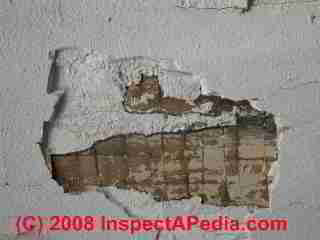
Site 288 test boards preserved from building exterior demonstrate improper surface preparation and skim coat basis of extensive paint failure
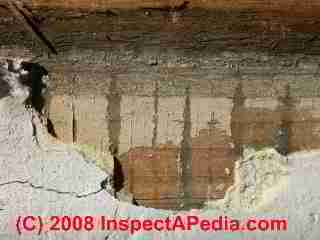
Site 289 test boards preserved from building exterior demonstrate improper surface preparation and skim coat basis of extensive paint failure
Readers should also see PAINT FAILURE CASE PHOTOS, SITE and then PAINT FAILURE CASE PHOTOS, LAB, and See PAINT & STAIN GUIDE, EXTERIOR for a guide to the selection and proper application of paints and stains on exterior wood surfaces.
...
Reader Comments, Questions & Answers About The Article Above
Below you will find questions and answers previously posted on this page at its page bottom reader comment box.
Reader Q&A - also see RECOMMENDED ARTICLES & FAQs
Question:
(Jan 20, 2013) Jim Delgado said:
I opened the entire ceiling yet there is no source of roof leaks yet the intersection of the wall to the ceiling has a small section of paint that droop down the wall looking like an elephants knees
. It seems as though water filled a sack and dragged the paint downward. Checking wood, drywall etc. there is no evidence of water entry and opening of the blister type droop shows no water and the paint bubble is detached from the [plaster wall...why?
Reply:
Paint droop such as you describe are usually traced to application of paint too thick on the wall or overpainting with a thick topcoat before the under-coat had dried. Typically the solvent in the wet paint causes partial dissolution of the undercoat paint layer and together they droop down the wall in a wrinkled "U" shape to give the elephant's knees paint job look you describe.
...
Continue reading at PAINT FAILURE LAB ANALYSIS or select a topic from the closely-related articles below, or see the complete ARTICLE INDEX.
Or see these
Recommended Articles
- PAINT FAILURE, DIAGNOSIS, CURE, PREVENTION - home
- PAINT FAILURE DICTIONARY - illustrated list of all types of paint failures
- PAINT FAILURE LAB ANALYSIS
Suggested citation for this web page
PAINT FAILURE SITE PHOTOS found at InspectApedia.com - online encyclopedia of building & environmental inspection, testing, diagnosis, repair, & problem prevention advice.
Or see this
INDEX to RELATED ARTICLES: ARTICLE INDEX to PAINTS & STAINS & FAILURES
Or use the SEARCH BOX found below to Ask a Question or Search InspectApedia
Ask a Question or Search InspectApedia
Try the search box just below, or if you prefer, post a question or comment in the Comments box below and we will respond promptly.
Search the InspectApedia website
Note: appearance of your Comment below may be delayed: if your comment contains an image, photograph, web link, or text that looks to the software as if it might be a web link, your posting will appear after it has been approved by a moderator. Apologies for the delay.
Only one image can be added per comment but you can post as many comments, and therefore images, as you like.
You will not receive a notification when a response to your question has been posted.
Please bookmark this page to make it easy for you to check back for our response.
IF above you see "Comment Form is loading comments..." then COMMENT BOX - countable.ca / bawkbox.com IS NOT WORKING.
In any case you are welcome to send an email directly to us at InspectApedia.com at editor@inspectApedia.com
We'll reply to you directly. Please help us help you by noting, in your email, the URL of the InspectApedia page where you wanted to comment.
Citations & References
In addition to any citations in the article above, a full list is available on request.
- Our recommended books about building & mechanical systems design, inspection, problem diagnosis, and repair, and about indoor environment and IAQ testing, diagnosis, and cleanup are at the InspectAPedia Bookstore. Also see our Book Reviews - InspectAPedia.
- Analysis of Modern Paints, Thomas J.S. Learner, Research in Conservation, 2004 ISBN 0-89236-779-2 [Chemistry of modern paints, overview of analytical methods, pyrolysis-gas chromatography signatures of basic modern paints and their constituents, Fourier transform infrared spectroscopy for paint analysis, direct temperature-resolved mass spectrometry, and analysis in practice - technical reference useful for forensic paint science, focused on art works -DF]
- Art, Biology, and Conservation: Biodeterioration in Works of Art, Robert J. Koestler et als. Eds., Metropolitan Museum of Art, 2003, ISBN 1-58839-107-8
- Building Pathology, Deterioration, Diagnostics, and Intervention, Samuel Y. Harris, P.E., AIA, Esq., ISBN 0-471-33172-4, John Wiley & Sons, 2001 [General building science-DF - ** Particularly useful text **
- Dampness in buildings, Diagnosis, Treatment, Instruments, T.A. Oxley & E.G. Gobert, ISBN 0-408-01463-6, Butterworths, 1983-1987 [General building science-DF]
- Paint and Surface Coatings, Theory and Practice, R. Lambourne & T.A. Strivens, Ed., Woodhead Publishing Ltd., William Andrew Publishing, 1999 ISBN 1-85573-348 X & 1-884207-73-1 [This is perhaps the leading reference on modern paints and coatings, but is a difficult text to obtain, and is a bit short on field investigation methods - DF]
- Paint Handbook: testing, selection, application, troubleshooting, surface preparation, etc., Guy E. Weismantel, Ed., McGraw Hill Book Company, 1981, ISBN-10: 0070690618, ISBN-13: 978-0070690615, [Excellent but a bit obsolete paint theory and practice, also a bit light on field investigation methods, out of print, available used-DF]
- In addition to citations & references found in this article, see the research citations given at the end of the related articles found at our suggested
CONTINUE READING or RECOMMENDED ARTICLES.
- Carson, Dunlop & Associates Ltd., 120 Carlton Street Suite 407, Toronto ON M5A 4K2. Tel: (416) 964-9415 1-800-268-7070 Email: info@carsondunlop.com. Alan Carson is a past president of ASHI, the American Society of Home Inspectors.
Thanks to Alan Carson and Bob Dunlop, for permission for InspectAPedia to use text excerpts from The HOME REFERENCE BOOK - the Encyclopedia of Homes and to use illustrations from The ILLUSTRATED HOME .
Carson Dunlop Associates provides extensive home inspection education and report writing material. In gratitude we provide links to tsome Carson Dunlop Associates products and services.


